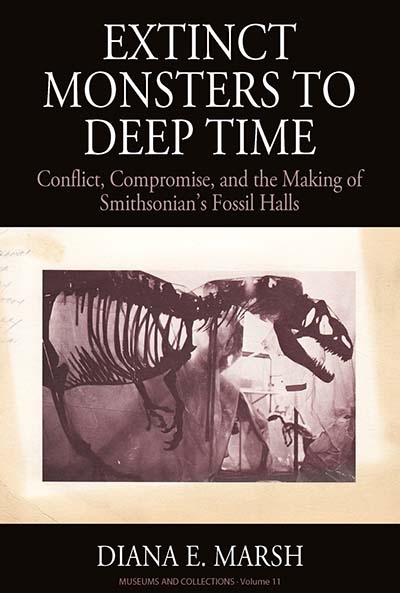A Review by Diana E. Marsh
As of May 5, 2020, the Smithsonian National Museum of Natural History’s (NMNH) virtual tour had been viewed by over one million online visitors. The 3D tour allows users to navigate through exhibit spaces, read texts, and view specimens. Users tap or click their way through the museums’ halls using virtual arrows along the floor of the galleries, or swipe to rotate up to 360° in one spot. They can also use a virtual floorplan to move into spaces of their choice.

On offer are the museum’s main permanent galleries: African Voices, the Bone Hall, the David H. Koch Hall of Human Origins, Eternal Life in Ancient Egypt, the Janet Annenberg Hooker Hall of Geology, Gems, and Minerals, the Kenneth E. Behring Family Hall of Mammals, the Sant Ocean Hall, Birds of DC, and the newest addition to the museum, the David H. Koch Hall of Fossils—Deep Time. Virtual visitors can also view some of the museum’s “temporary” halls (usually up for 5 years or fewer), including Objects of Wonder, Sea Monsters Unearthed: Life in Angola’s Ancient Seas, and the increasingly relevant Outbreak: Epidemics in a Connected World. The virtual tour also includes some of the museum’s educational and interactive spaces, including the O. Orkin Insect Zoo, the Butterfly Pavilion, and Q?rius: the Coralyn W. Whitney Science Education Center. One can even peruse the gift shops.
While there are a few “glitches” when one reaches the limits of what is viewable—returning the viewer to a previous view, for instance, when desiring to continue forward—the platform works well on both desktop and mobile devices. On either, viewers can zoom enough to read most exhibit panels and see some specimen detail. (Individual object labels, however, are not always legible.)
Additions to the NMNH’s virtual tour have come as Smithsonian has endeavored to increase its digital offerings over the last two and a half months. At the NMNH, where the recently refurbished website follows a primarily “visit and contact” model, the quick launch of a virtual tour for even the museum’s newest galleries was no small feat, and is evidence of wider interest across the Smithsonian in providing online resources for home use (see, for instance, Smithsonian’s Learning Lab for creating lesson plans, the newly launched Smithsonian Open Access platform, and a list of other Smithsonian virtual offerings from Smithsonian.com).

Perhaps the most detailed of the NMNH’s permanent exhibit tours is the new Deep Time hall, which opened in June after more than 7 years in development and contains 40 distinct sections for visitors to explore virtually (only Geology, Gems, and Minerals comes close, with 27 sections). The virtual tour can be augmented with an Audio Description app for the hall, which was designed for blind and low-vision visitors, but during the pandemic the virtual environment provides greater detail about each section of the show for anyone wanting a deeper dive.
In the Deep Time virtual tour, visitors can explore the history of life on Earth and humanity’s recent influence on the planet, while getting their dinosaur fix. As an ethnographer of early stages of the project, I found the most satisfying part of the virtual tour to be the “Overlook of the Whole Exhibition.” Even more than being there in person, the wide-angle lens from which digital visitors see what its architects called “the bridge” accomplishes the goal of that space—to present the vast sweep of geologic time covered in the hall from the unique vantage point of the human perspective. Free from other visitors and with no soundscape of interactive videos emanating from various corners, users can look back from the Permian (251–299 million years ago) to the Pleistocene (2.6 million–11,000 years ago) and see the major extinctions and characteristics that marked this progression of time.


Although it would be satisfying to be able to interact with the exhibit’s media elements, the tour’s visual components will be satisfying to many visitors who missed the hall during its five-year closure, and now do not know when in-person visits will again be possible.
Access the Smithsonian National Museum of Natural History’s Virtual Tour
Diana E. Marsh is a research anthropologist and museum practitioner who studies how heritage institutions communicate with the public. She is currently a Postdoctoral Fellow at the National Anthropological Archives at the Smithsonian’s National Museum of Natural History, where she is working to increase the accessibility of archival collections.
RELATED TITLE
2019 COUNCIL FOR MUSEUM ANTHROPOLOGY AWARD – HONOURABLE MENTION
EXTINCT MONSTERS TO DEEP TIME
Conflict, Compromise, and the Making of Smithsonian’s Fossil Halls
Diana E. Marsh
Foreword by Jennifer Shannon
Extinct Monsters to Deep Time is an ethnography that documents the growing friction between the research and outreach functions of the museum in the 21st century. Marsh describes participant observation and historical research at the Smithsonian’s National Museum of Natural History as it prepared for its largest-ever exhibit renovation, Deep Time. As a museum ethnography, the book provides a grounded perspective on the inner-workings of the world’s largest natural history museum and the social processes of communicating science to the public.
Read Introduction
